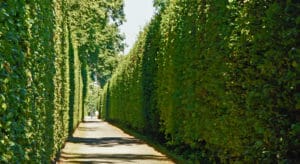Many of us are familiar with the energy-saving properties of trees in summer. By providing shade, trees can reduce cooling energy costs by 15% to 20%. But trees can also bring significant energy savings in winter, particularly in cold, windy areas, where they can act as a wind blocker. In this post we’re taking a look at how to plant trees in order to lower your wintertime energy bills.
Planting evergreen trees and shrubs as wind blocks has been shown to be an effective way to achieve energy savings. In windy areas where the winters are often bitterly cold, windbreaks not only mitigate the force of strong winds, but also keep snowdrifts from forming in problematic places, such as roads and intersections. A well-designed windbreak takes into consideration multiple aspects, including wind-direction, planting density, proper placement, and more. To achieve maximum efficiency, we recommend working with our Portland certified arborists when designing your wind breaking line of trees and/or shrubs. When properly done, a windbreak can reduce heating costs by 10% to 25%.
 Windbreak vs. Insulation. Your location will define whether you need a windbreak or a landscape design that favors insulation. Wind barriers are used to channel wind away and around buildings, while denser plantings closer to a structure will offer insulation and control the distribution of snow. For mountain homes, insulation plantings are beneficial, but their placement must be balanced with the need to reduce the threat of wildfires in summer months.
Windbreak vs. Insulation. Your location will define whether you need a windbreak or a landscape design that favors insulation. Wind barriers are used to channel wind away and around buildings, while denser plantings closer to a structure will offer insulation and control the distribution of snow. For mountain homes, insulation plantings are beneficial, but their placement must be balanced with the need to reduce the threat of wildfires in summer months.
Where to plant? The math here depends on the height of your wind breaking trees and/or shrubs. Experts recommend placing wind blocks 2 to 5 times the height of the windbreak away from the structure it is intended to protect. As an example, a wind block of 30-foot-tall trees should be placed 60 to 150 feet away from the building. Wind direction should also factor into placement. Prevailing winds tend to come from the north or the west, so planting on these sides should be favorable. Avoid planting tall trees on the south-side of your home as that tends to be the sunniest side. This also allows for a reduction in heating costs due to the effects of passive heating.
Density. For windbreaks, density boosts effectiveness. For this reason, evergreens are often recommended for wind blocks. Trees should be planted in a manner that allows the crowns to overlap, but wind blocks can be planted in a variety of configurations. To insulate, evergreen shrubs should be planted near, but slightly away from, buildings.
No perfect solution. Because each location offers its own set of variables and challenges, there is no universally perfect windbreak design. We suggest getting in touch with a certified arborist for expert windbreak tree planting. Portland residents can call us for advice on creating an effective wind block. Consultations are one of our many Portland tree services. While an urban home may not have much space for wind breaking trees, we can still recommend a planting design to cut your energy bills. Our Portland certified arborists understand the challenges of wind blocks, and are able to customize their planting recommendations to the particular nuances of your property. Talk to us today about how to plant trees that will keep saving you money on energy bills for many years to come.